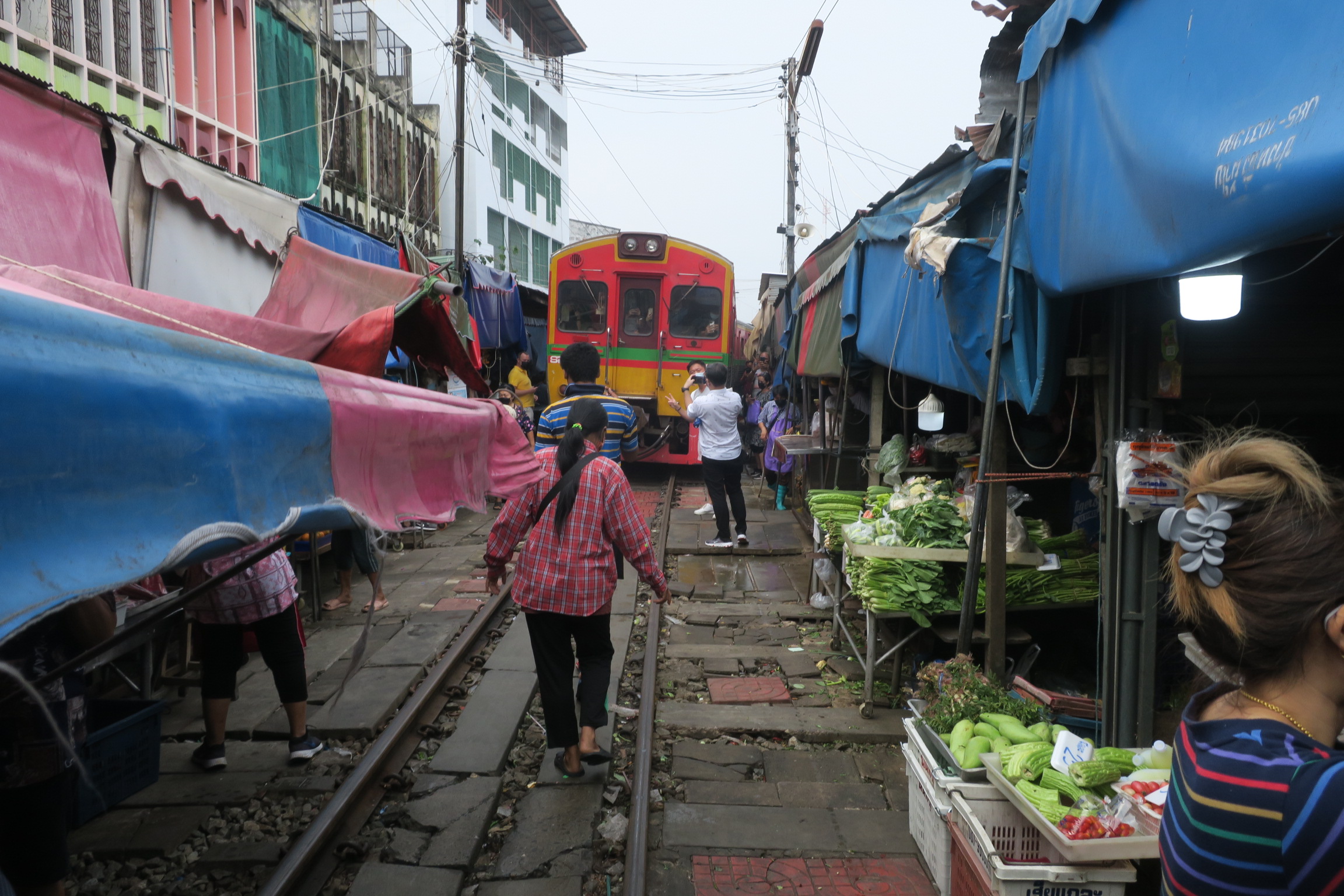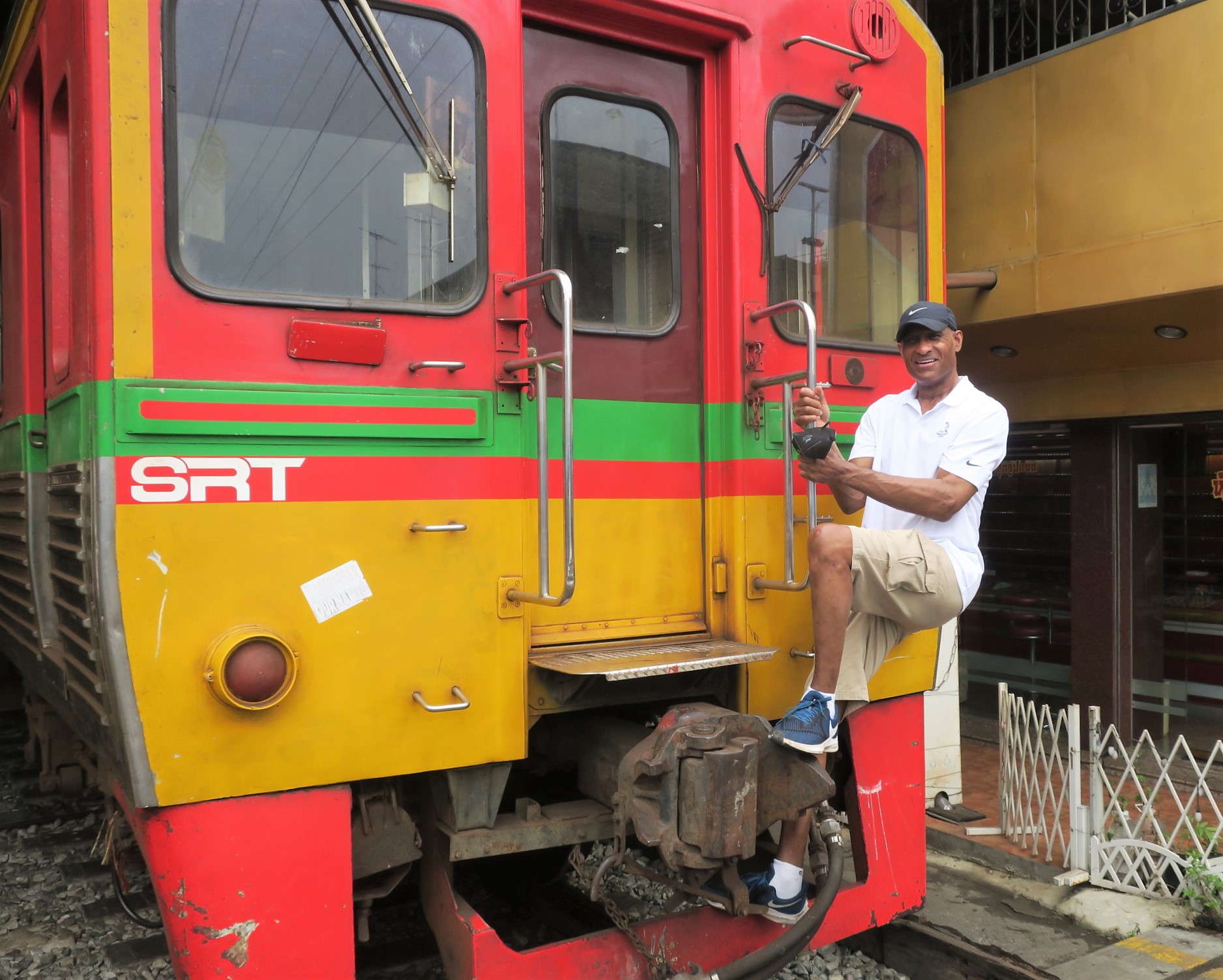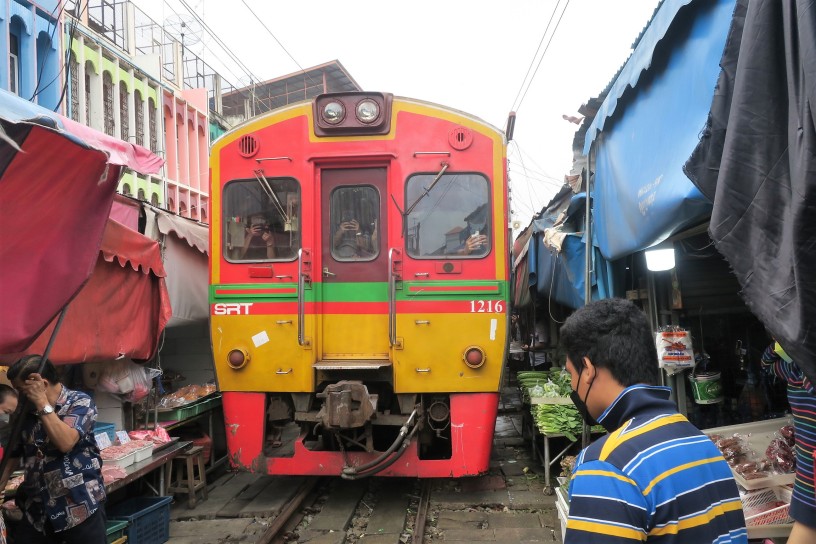Only something really special could convince me to book a group tour that was primarily devoted to shopping. In this case, the chance to see a crowded market with a freaking train running through it was enough to overcome my reluctance to sign up for a group shopping tour.
The inspiration for this adventure came from a post by a great travel blog I follow – Leighton Travels. His post on Hanoi Train Street was the first I’d heard of the concept of a train market.
Which Came First: The Market or the Railway?
The previous post reviewed the other stop on this tour, Damnoen Saduak Floating Market. Specifically to attract tourists, the Tourist Authority of Thailand created that venue in the 1970s to duplicate the original floating markets that sprang up on the canals when they were built in the 19th century.
On the other hand, Maeklong Railway Market evolved naturally. Samut Songkhram, the province where the market is located lies 60 miles soutwest of Bangkok where the Maeklong River flows into the Gulf of Thailand.

Around the year 1900, a rail line was constructed to transport goods from the fishing ports and markets of Samut Sakhon and Samut Songkram to markets in Bangkok. They built the line right through the preexisting market to its terminus at the adjacent Maeklong River. The people who ran the market saw no reason to relocate just because trains came through up to eight times per day.

It Is a Real Market
The market is best known for seafood, but stalls also sell a variety of products such as fruit, vegetables, meat, snacks, clothing, and flowers. Goods are primarily intended for purchase by locals rather than tourists.



The Thai nickname for this market is the “Umbrella Take Down Market.” The name stems from the practice of lowering the awnings over their stands just before the train passes and raising them immediately after it passes.
A loud blast from the engine is the signal to immediately lower the awnings.

Stand owners raise the awnings within seconds after the train passes.

Vendors make way for the train by rolling away tables mounted on wheels or dragging away baskets.

The train actually passes over goods that are left next to the track.
Train Coming Through
The train appears only seconds after the track is cleared.

Even though Maeklong station is quite close, the train moves through the market at a good clip. Anything that gets in its way and is higher than the ground clearance will be road kill.
My three second video provides a sense of the speed. The train moved faster than I anticipated. I had to get out of the way quickly.

It is important to be aware of your position relative to the track. I suspect there have been accidents although I found no online information referencing any. The safest spot for photos is the station just a few meters past the market.

The Most Interesting Way to Get to Maeklong Railway Market
The way to see Maeklong Railway Market in action without incurring any risk of being run over by the train is to be on the train. From Bangkok you can take the Maeklong Railway from Wongwian Yai Skytrain Station on the Silom Line.
The trip from Wongwian Yai to Mahachai Station on the Tha Chin River takes one hour. Passengers get off there, take a ferry across the river, board another train at the Ban Laem Station, and ride for another hour and 40 minutes to Maeklong Station. The market is immediately in front of Maeklong Station which sits on the banks of the Maeklong River.

Although the train is slow and not much to speak of as far as comfort (no air conditioning), it is the least expensive way to get to Maeklong Train Market. The cost is 23 baht (less than $1) one way. The journey takes 2.5 hours each way.

Despite the time required, taking the train deserves strong consideration for a one-way trip at least. Taking the train offers up-close views of the countryside and the best perspective of the train going through the market.
Nearby Activities
After the train went through, I walked around the area to see the sights before the tour returned to Bangkok. There are many restaurants and shops in the immediate vicinity.

I stopped to watch a performance at a temple that was celebrating a festival.

There is a pier on the Maeklong River adjacent to the train station from which ferries and short cruises depart.

Kwae Noi River (River Kwaii) of book and movie fame is one of the Maeklong’s principal tributaries.

Overall Impression
I recommend visiting Maeklong Train Market if you are in Bangkok. A massive train passing inches from your face through what was a lively market moments before is not something most people see every day. It was an unique and memorable experience.
Would do you think of Maeklong Railway market? Would you consider adding it to your itinerary on a trip to Thailand?

Woha, simply mind blowing scenes John!
Looks like an ideal place to explore, looking at all of these stunning sceneries.
This brings back memories on an expedition I took part in the beautiful island nation of Sri Lanka in South Asia.
I set out on a journey to explore the longest river of Sri Lanka; River Mahaweli with a group of kayakers paddling for 3 long days.
And trust me when I say this, it was ‘heaven on earth” from lush greenaries to all the flora and fauna simply captivated me. Read the full story here, https://sachsattic.wordpress.com/2022/07/24/exploring-the-river-mahaweli-on-a-kayak/
LikeLiked by 1 person
I enjoyed reading your post about the fantastic kayak trip. I haven’t done anything like that. Thanks for checking out my post about the railway market.
LikeLike
I missed a few of your posts, glad you reposted them in this format. The train market is such a crazy Thai experience. We visited it as well a couple of years ago. The merchants have it all down to a science. Maggie
LikeLiked by 1 person
You are right about the merchants, Maggie. I still don’t understand why the market didn’t move. Has space always been too limited to find another area nearby in Maeklong? Oh well, the market is a great tourist attraction.😊 John
LikeLike
Unique market 👌👌
LikeLiked by 1 person
Very much so. Thanks for visiting.
LikeLike
I remember Leighton’s post about the train market, and if I were to go back to Thailand, I would look for it as well. Fascinating post and photos! It would be interesting to see the vendors hurriedly moving the tables on wheels out of the way.
LikeLiked by 1 person
It takes only 10 seconds for a couple of people at each stand to lower the awnings and move the stuff out of the way – amazing. I appreciate your reading and leaving a kind comment Ruth.
LikeLiked by 1 person
its unique and a cool experience! Kudos to you John for actually researching it!
LikeLiked by 1 person
My pleasure. Glad you liked the post.
LikeLike
Humbled from looking at the compactness of everything and everyone. Never again will I complain about not having enough space! Thanks for this superb piece.
LikeLiked by 1 person
It is amazing that they never moved the market. Thanks for dropping by and commenting!
LikeLike
That is a wild market! Can’t imagine anything like that in the US
LikeLiked by 1 person
Lawyers would never allow it here.😄
LikeLiked by 1 person
I’m totally amazed at how close everything is to the train track!! It seems impossible the market can survive intact in such a location.
LikeLiked by 1 person
People who work there seem to be unfazed. The market’s survival is a testament to the ingenuity of Thai people.
LikeLiked by 1 person
Wow it looks so dangerous! I know they have closed some similar down recently haven’t they, so I like this one is still going – it must bring a lot of business to the market and boost the local economy.
LikeLiked by 1 person
The train market is absolutely insane. They say the market was there before the train was built around 1905; so tourism wasn’t the original motivation for it. What a sight!😄
LikeLike
What a unique market to visit. It’s neat how the vendors have found a way to adapt to the train running through the market.
LikeLiked by 1 person
I guess they thought it was easier than moving the market. I wonder what they did while the tracks were being built.
LikeLiked by 1 person
wow hold on to your hat and bring ear plugs for this shopping experience John when you finally get the chance to see it! 💖👏
LikeLiked by 1 person
Normally shopping is only a threat to my bank account. This market is on another level. Ha ha! Thanks for all of your kind and generous comments Cindy! 😉💓
LikeLiked by 1 person
it sure looks as such.. hahaha yes indeed. It’s my pleasure! 💖
LikeLiked by 1 person
Thank you John for the mention and taking the time to link back to the article. This market looks amazing, wish I’d visited when I was in Thailand. It goes to show how incredibly resilient Thai people are: taking down their stall umbrellas and moving out of the way every time a train passes. Remarkable story!
LikeLiked by 1 person
Hanoi Train Street looked so cool, I had to see the market in Thailand. I agree about Thai people. They are incredibly resilient and resourceful. The Train Market is Exhibit A. Thanks for the tip.
LikeLiked by 1 person
Wow, never seen such Railway images …
Bernhard
LikeLiked by 1 person
Thanks Bernhard for taking a peek at the post. It is a real compliment if you like the images.
LikeLiked by 1 person
I am a railway fan, in reality and in model 😀
Bernhard
LikeLiked by 1 person
Then I think taking the train would be the perfect way for you to visit this market. That is what I’ll do if I go back. 😊
LikeLiked by 1 person
But i fear, i will never be in this area to use this train 😦
Bernhard
LikeLiked by 1 person
That is unfortunate although I assume there are interesting railways and trains in your neck of the woods. Thanks Bernard for following and commenting of the post.
LikeLike
That is very interesting..
Thanks for sharing.
LikeLiked by 1 person
My pleasure. Thanks for giving the post a look. The train system in India can be an adventure at times. I don’t know if there is anything like this though.
LikeLike
I loved this tour! Some of my fondest memories and photos are from my day at this market, where I met lasting friends who were part of the tour group. Such fun!
LikeLiked by 1 person
The market is a potential train wreck. Who wouldn’t want to see that? Ha ha! So cool that you were able to make friends on the tour. That is a real plus for us solo travelers.
LikeLike
I saw this market beside a railway track in a documentary film. How crazy!
LikeLiked by 1 person
I’d like to see the documentary. This market is the poster child for crazy.😊 Thanks for adding to the story with your comment.
LikeLiked by 1 person
I’ve been to Hanoi Train Street although unfortunately not when a train was passing. This looks even more amazing as there’s so much to move out of the way and back again each time! I’d love to see it!
LikeLiked by 1 person
When the railway was constructed I guess the open space for the market was the easiest route. Thai people continually impress me with their ability to adapt.
LikeLiked by 1 person
I’ve seen this on Instagram, it’s amazing how close everything is to the track. Nonetheless, looks like a great place to visit
LikeLiked by 1 person
I read that a very popular instagrammer caught a lot of flack for her selfie in front of the train. If I go back, I’d like to ride the train. Take care Natty!
LikeLiked by 1 person
When I first heard about this market, I thought, Are they crazy? The simple answer is Yup. But if you know when the train is coming and how it goes through the market, why not. Thanks for the post John. Allan
LikeLiked by 1 person
Those crazy Thais!😊 I have to give them credit for ingenuity and resourcefulness.
LikeLiked by 1 person
Great post. I would and have visited. Unfortunately the tracks were closed for repairs when we went. Guess i have to go back.
LikeLiked by 1 person
A shame the train wasn’t operating Sandy. I hope you get to see it one day. Thanks for coming by and sharing your experience. Have a great weekend!
LikeLiked by 1 person
I give a tip of the hat to those merchants, I’d be a nervous wreck under such circumstances.
LikeLiked by 1 person
Talk about a dangerous workplace! The merchants seem to look out for each other and tourists. An accident would be a tragedy for all.
LikeLiked by 1 person
Yes, I also saw this on Leighton’s blog for the first time. It’s just unimaginable that you can stand in the middle of a market … on a (real) traintrack! And 8 times a day – that’s quite a busy train!
LikeLiked by 1 person
And the train is so cheap! I don’t see how they do it.
LikeLiked by 1 person
So interesting. I would be terrified 😅. I like how the locals are completely unfazed by that train.
LikeLiked by 1 person
Although the train attracts some customers, it is probably more of a nuisance to them. The locals see the train about eight times a day. Be well and safe! ☺
LikeLiked by 1 person
Wow! I am impressed! As the train goes through the market or the market… Omg!
Great photos, very interesting post. Thank’s for share, John.
Nice weekend.
Elvira
LikeLiked by 2 people
The train market was different to say the least.😄 My weekend is going well. I hope your have a terrific day Elvira! John
LikeLike
Good experience! I am glad hear it.
Thank you, John. Hope too!
Keep well, Elvira
LikeLiked by 1 person
😃
LikeLiked by 1 person
Ha ha! Enjoy every day!
LikeLike
Thank’s! I will! 😊
LikeLiked by 1 person